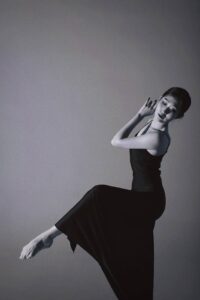Renowned dance artist Tianyi Li, invited to perform at Craft Central in London, showcases her masterpiece The Seventh Rose – a performance that stands as a testament to the evolving dynamics of contemporary dance. This avant-garde creation, merging Eastern and Western dance aesthetics, premiered at a dance theater in December 2022 and has since captivated audiences with its nightly performances December, 2023.
The Seventh Rose has earned widespread praise for its bold choreographic innovations and significant influence on dance culture. This in-depth review offers a comprehensive analysis of the performance, focusing on body technical elements, artistic choices, and the unique engagement with its audience.
Blending Cultures: The Essence of ‘The Seventh Rose’
The Seventh Rose is a vibrant fusion of Eastern and Western dance traditions, marking a significant evolution in contemporary dance. Tianyi Li’s choreography is a language in itself, bridging cultural divides through a blend of Eastern curves and Western straight lines, infusing ballet’s grace with a unique touch. Her elongated movements articulate a philosophy of bodily artistry, reshaping the landscape of contemporary dance with a distinct personal style.
The Seventh Rose goes beyond traditional dance boundaries, creating a dynamic interplay between heritage and contemporary creativity. Tianyi’s perspective on tradition and innovation stresses the importance of self-expression and the freedom to define one’s artistic methods. During rehearsals, Tianyi’s approach to directing her dancers is unique and deeply personal. She strives to ensure that each dancer’s performance is devoid of any distinct traces of their dance training. Tianyi’s vision is for the dancers to embody a state of pure self-expression, where their bodies become vessels for their individuality, allowing them to execute movements based on their personal interpretations and feelings.
To achieve this level of authentic and uninhibited expression, Tianyi emphasizes the need for her dancers to undergo diverse and multifaceted physical training. This approach is not just about mastering various dance techniques; it’s about enabling dancers to break free from the conventional molds of specific dance genres. By doing so, they can explore a broader range of motion and emotion, thus transforming their bodies into more versatile and expressive instruments.
Tianyi’s philosophy in dance challenges the traditional norms and encourages a fusion of personal identity with artistic expression. This creates a dance experience that is not only visually captivating but also deeply resonant with the dancers’ own experiences and emotions. Her method fosters an environment where creativity is not bound by rigid structures but is instead driven by the dancers’ own instincts and personal narratives. Her choreographic evolution is marked by a refusal to adhere to predefined styles, focusing instead on expressing her unique artistic voice.
‘Interwoven’: A Choreographic Triumph
The standout segment, “Interwoven,” is a choreographic gem that explores themes of femininity and cultural identity. It’s a part of the seven distinct segments that make up The Seventh Rose, each symbolically connected to the title. Tianyi’s background in dance traditions enriches the performance, blending ballet’s linear precision with the flowing grace of traditional Chinese dance. This fusion creates a striking visual narrative, redefining dance aesthetics.
The performance’s use of the rose petal motif and flowing skirts symbolizes various feminine roles, fostering a dialogue with the audience through Tianyi’s interpretation of life experiences. This approach transcends traditional dance boundaries, offering an immersive exploration of femininity and cultural nuances.
In theater performances, Tianyi intricately divides into seven distinct parts or layers, each symbolizing a different stage in a woman’s life. This thematic segmentation reflects the complexity and the multifaceted nature of the female experience, from youth to maturity. Each part of the performance is crafted as a separate visual tableau, characterized by unique color schemes. These colors are not chosen randomly; they are deeply connected to Tianyi’s intuitive responses to each life stage. For instance, the use of different colors of roses in each segment stems from her instinctual feelings about the specific phase of life they represent.
The choice of roses, with their universal symbolism of beauty, passion, and complexity, is particularly poignant. The varying hues of the roses convey diverse emotions and experiences – from the innocence and freshness of light-colored roses to the intensity and depth of darker shades. This artistic decision not only adds a rich visual dimension to the performance but also deepens the narrative, allowing the audience to journey through the spectrum of female experiences, emotions, and transformations.
Through this layered and color-coded structure, this dance masterpiece becomes a vivid and emotive exploration of womanhood, resonating with audiences on both a visual and emotional level. Each stage with its distinct color and thematic focus, invites the audience to reflect on the various aspects and transitions in a woman’s life.

Redefining Space and Audience Interaction
After a year of adjustments and re-staging, Tianyi Li took a bold and innovative step with her work. Following the conclusion of her theatrical performances, she “deconstructed” her piece in different parts and brought it into various art spaces for re-staging. One such performance at Craft Central London offered a unique and immersive experience, distinct from the traditional theater setting.
At Craft Central, the conventional boundaries between audience and dancer were dissolved, creating a deeply immersive experience. This shift from a conventional theater to an art center allowed for a more intimate and interactive engagement with the performance. In this setting, the audience wasn’t just a passive observer; they became a part of the performance, experiencing the dance in a more tangible and personal way.
This immersive experience was likely enhanced by the unique architecture and ambiance of Craft Central. The art space would have provided a different kind of canvas for Tianyi’s work, where the interaction between the space, the dancers, and the audience could evolve organically. Such a setting would allow for a more dynamic and fluid performance, with the dancers adapting their movements to both the physical environment and the immediate reactions of the audience.
Tianyi decision to bring her work different part into art spaces like Craft Central signifies a creative exploration beyond the confines of traditional performance venues. It reflects her willingness to experiment with how dance is experienced and how it interacts with different environments, thereby enriching the audience’s engagement with her art. This approach not only diversifies the presentation of dance but also expands the possibilities of how dance can be perceived and understood.
Tianyi Li: A Pioneer in Contemporary Dance
Tianyi Li stands as a pioneering figure in contemporary dance. Her unique blend of Eastern and Western dance traditions, combined with personal experiences and emotions, defines her distinctive choreographic style. Her work transcends physicality, exploring emotional depths and offering audiences a journey into serenity and emotional depth.
Tianyi Li’s artistic philosophy in her dance performances is deeply rooted in the pursuit of authenticity. She believes in experiencing beauty through realism, especially as a dancer, where the body becomes a medium for expressing artistic ideas. According to Tianyi, the human body presents the most genuine state of being, and expressing through it is incomparable.
This belief is evident in her reluctance to incorporate new media or technological elements in her performances. Unlike many contemporary artists who use technology to create interactive experiences, Tianyi prefers the presence of live performers. The simplicity of a few dancers standing on stage, without any words, yet conveying profound emotions, underscores the power of the human body in dance.
Tianyi’s approach highlights the body’s charm and its ability to communicate deep feelings and thoughts, setting her apart in the world of contemporary dance. Her work, thus, becomes a testament to the raw, unadulterated expression of human emotions through the art of movement.
Tianyi Li places a significant emphasis on intuition in her dance creative process. Her inspirations often stem from her immediate reactions to events or objects she encounters, which then become the central themes of her works. This instinctive approach is particularly evident in her choreography, especially in group dances. She encourages her dancers to engage in group improvisation, allowing them to freely express themselves while she observes, records, and organizes their movements. This method leads to a unique synergy, as the varied physicality’s and textures of different dancers interact, often resulting in unexpected and captivating transformations.
Moreover, Tianyi integrates her thinking of the world into her choreography. The final presentation aligns with her initial intuition yet invites deeper contemplation. This blend of instinctive creation and thoughtful composition not only reflects Tianyi’s artistic vision but also adds layers of meaning to her performances, making them both authentic and intellectually stimulating.
The Seventh Rose has been critically acclaimed for its innovative choreography and its impact on the cultural discourse within dance. Tianyi Li’s navigation between tradition and innovation, along with her utilization of alternative spaces, signifies transformative possibilities within contemporary dance. Her work redefines the contours of this art form, leaving a lasting impact on its evolution.
















